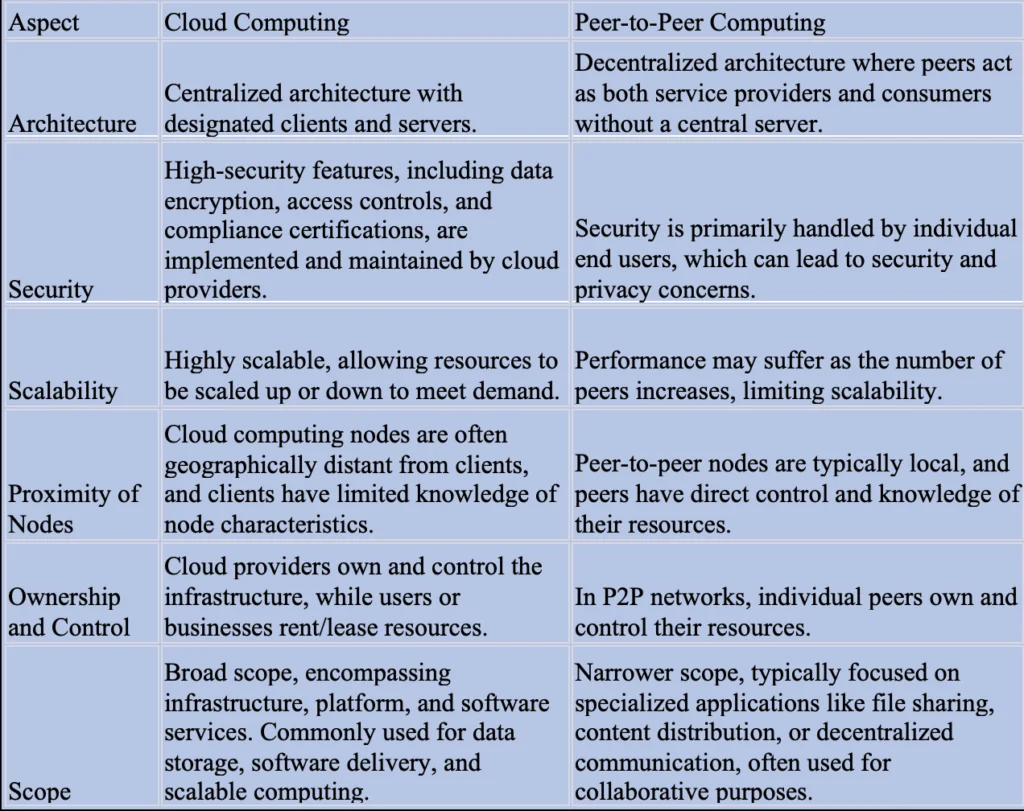Peer-to-peer systems and clouds share a few goals, but not the means to accomplish them. Compare the two classes of systems in terms of architecture, resource management, scope, and security.
Differences Between Cloud And Peer To Peer Computing
The Differences Between Cloud and Peer to Peer computing is as follows:
a) The main differences between Cloud and peer to peer computing is that in the Cloud architecture, there are designated clients that request for services and servers that provide services, but in peer-to-peer systems, peers act as both service providers and service consumers without a central server.
b) In the Cloud system, there are high-security features such as data encryption, access controls and compliance certifications as compared to peer-to-peer systems where security is handled by the end users which pose security and privacy issues.
c) Peer-to-peer networks suffer in performance as the number of nodes increases, but in the Cloud, systems can be scaled as much as one desires.
d) In Peer-to-peer systems, computing nodes are local; but, in Cloud systems, computing nodes are very far and clients taking services from these nodes do not know any characteristics of these nodes.
e) Another difference between peer to peer and cloud computing is P2P networks resources are usually handled and own by individual peers whereas In cloud computing Users or Businesses rent/lease resources from cloud providers. Providers are the one to own the infrastructure and maintain full control over the networks.
f) Cloud computing has an extensive scope that includes infrastructure, platform, and software services that are commonly utilised for data storage, software delivery, and scalable computing.
Peer-to-peer computing, on the other hand, is typically focused on specialised applications such as file sharing, content distribution, or decentralised communication, and is mostly employed when peers collaborate for a common objective.
This table highlights the key differences between cloud computing and peer-to-peer computing in terms of their architecture, security, scalability, node proximity, ownership and control, and scope.

FAQs
What are the Differences Between Cloud And Peer To Peer Computing?
The main differences between Cloud and peer to peer computing is that in the Cloud architecture, there are designated clients that request for services and servers that provide services, but in peer-to-peer systems, peers act as both service providers and service consumers without a central server.
Can both cloud and peer-to-peer systems be scaled to meet increased demand?
Cloud systems are easily scalable, allowing resources to be scaled up or down as per demand. Peer-to-peer systems may downgrade their performance as the number of peers increases making it hard for scalability.
Who owns and controls the resources in these systems?
In cloud computing, cloud providers own and control the infrastructure, while users or businesses rent/lease resources. In peer-to-peer networks, individual peers own and control their resources.
How does security differ between the two systems?
Cloud computing often has high-security features, such as data encryption, access controls, and compliance certifications, implemented and maintained by cloud providers. In contrast, security in peer-to-peer systems is primarily the responsibility of individual end users, which can lead to security and privacy issues.

